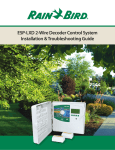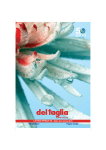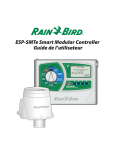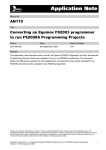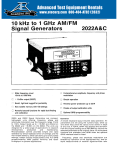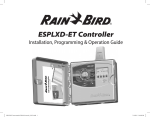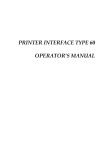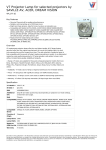Download ESP-LXME Control System Installation & Troubleshooting Guide
Transcript
ESP-LXME Control System Installation & Troubleshooting Guide Contents ESP-LXME Control System Overview. . . . . . . . . . . . . . . . . . . . . . . . . . . . . . . . . . . . . . . . . . . . . . . . 3 ESP-LXME Controller & Modules. . . . . . . . . . . . . . . . . . . . . . . . . . . . . . . . . . . . . . . . . . . . . . . . . . . . . 4 ESP-LXME Controller Option Cartridges . . . . . . . . . . . . . . . . . . . . . . . . . . . . . . . . . . . . . . . . . . . 5 Rain Bird LIMR Controller Remote. . . . . . . . . . . . . . . . . . . . . . . . . . . . . . . . . . . . . . . . . . . . . . . . . . . 5 ESP-LXD Control System Flow & Weather Sensors. . . . . . . . . . . . . . . . . . . . . . . . . . . . . . . . 6 Rain Bird Weather Sensors. . . . . . . . . . . . . . . . . . . . . . . . . . . . . . . . . . . . . . . . . . . . . . . . . . . . . . . . . . . . 7 Rain Bird ESP-LXD Series Controller Enclosures. . . . . . . . . . . . . . . . . . . . . . . . . . . . . . . . . . . 8 Grounding & Surge Protection. . . . . . . . . . . . . . . . . . . . . . . . . . . . . . . . . . . . . . . . . . . . . . . . . . . . . . . 9 Flow & Station Management. . . . . . . . . . . . . . . . . . . . . . . . . . . . . . . . . . . . . . . . . . . . . . . . . . . . . . . . 10 Rain Bird ESP-LXME Controller Installation Checklist. . . . . . . . . . . . . . . . . . . . . . . . . . . 13 ESP-LXME Control System Diagnostics. . . . . . . . . . . . . . . . . . . . . . . . . . . . . . . . . . . . . . . . . . . . 14 ESP-LXME Control System Troubleshooting. . . . . . . . . . . . . . . . . . . . . . . . . . . . . . . . . . . . . . 16 Rain Bird Technical Services (RBTS) ESP-LXME controller support is available from Rain Bird Technical Services (RBTS). Contact RBTS at 800 RAINBIRD (800) 724-6247 (U.S. and Canada). Rain Bird Spec Hotline Please call the Rain Bird Spec Hotline number at 800-458-3005 (U.S. and Canada) for assistance with specifying an ESP-LXME Control System. You may also send an email with questions to: [email protected]. For information contained in this guide related to troubleshooting, please contact GSP support (see above). Specifications Tools Specification tools including CAD Details and Written Specifications for the Rain Bird ESP-LXME Series Control System can be found at www.rainbird.com/esplxseries Copyright © 2013 Rain Bird Corporation. All rights reserved. No part of these materials may be reproduced by any means, nor translated into machine language, without written permission of the publisher. Rain Bird®, ET Manager™, IQ Central Control System™, FloWatch™, FloManager™, FloZone™, and SimulStations™ are trademarks of the Rain Bird Corporation. All rights reserved. 2 ESP-LXME Control System Installation & Troubleshooting Guide ESP-LXME Control System Overview A Rain Bird ESP-LXME Series Controller provides control of small to large irrigation systems. The ESP-LXME traditionally-wired controller offers a modular station capacity expandable from the base 8 or 12 stations to 48 stations using 4-, 8-, and 12-station modules. Flow sensing is standard on ESPLXMEF model controllers. Flow sensing can be added to ESP-LXME models by installing a FSM-LXME Flow Smart Module. An ESP-LXME controller can operate up to five (5) 24 VAC solenoid valves simultaneously depending on the number of modules installed and the configuration and programming of the controller. One (1) master valve output and one (1) weather sensor input are provided on the base controller module. 24 VAC is also provided to power wireless weather sensors. The optional Flow Smart Module provides input for one (1) flow sensor. One valve power wire for each station 1 and master valve 3 is run between the controller and valve location. A valve common wire 2 interconnects the controller and all station and master valves in the system. 1 3 2 Power Wire Master Valve Common Wire Controller to Valve Wire Connections ESP-LXME Control System Installation & Troubleshooting Guide 3 ESP-LXME Controller & Modules ESP-LXME Series Controllers The ESP-LXME Series Controllers have a base capacity of either 8- or 12-stations depending on the model. The station capacity can be expanded to a maximum of 48-station in 4-station increments using 4-, 8-, and 12-Station Modules. The ESP-LXME controller is equipped with a Base Module that provides one (1) common wire output, one (1) master valve output, one (1) weather sensor input, and one (1) 24 VAC power output. 4- & 8-Station Modules Single Height 12-Station Module Double Height Base Module Single Height ESP-LXMEF Series Controllers The ESP-LXMEF Series Controllers have a base capacity of either 8- or 12-stations depending on the model. The station capacity can be expanded to a maximum of 48-station in 4-station increments using 4-, 8-, and 12-Station Modules. The ESP-LXMEF controller is equipped with a Flow Module that provides one (1) common wire output, one (1) master valve output, one (1) weather sensor input, one (1) 24 VAC power output, and one (1) flow sensor input. Flow Smart Module Double Height 4 ESP-LXME Control System Installation & Troubleshooting Guide ESP-LXME Controller Option Cartridges ETC-LX ET Manager™ Cartridge The Rain Bird ET Manager Cartridge easily upgrades the ESP-LXME Series Controllers to an ET/ Weather-based irrigation smart controller. Available in most part of North America only, and requires a signal provider for your geographic area. IQ Central Control Compatible Through the incorporation of an IQ-NCC Communication Cartridge, the ESP-LXME controller can be controlled from the Rain Bird IQ™ Central Control System. Communication options: -GP GPRS/ Cellular, -PH Phone, -EN Ethernet, -WF Wi-Fi, and -RS RS-232 (RS-232 used for Radio or Direct Connect) Rain Bird LIMR Controller Remote LIMR-KIT 900MHz Transmitter, Receiver, Quick-Connects, Carrying Case LIMR-TX 900MHz Transmitter Only LIMR-QC603 6-Pin Quick Connect Cable, 3 feet LIMR-QC630 6-Pin Quick Connect Cable, 30 feet LIMR-RX 900MHz Receiver Only ESP-LXME Control System Installation & Troubleshooting Guide 5 ESP-LXMEF Control System Flow & Weather Sensors Rain Bird FS-Series Flow Sensors One (1) flow sensor can be connected to the ESP-LXMEF Controller Flow Smart Module. FS-Series Flow Sensors are available in ½” to 4” PVC Tee, 1” to 2” Brass Tee, and Brass and Stainless Steel Insert Style models. Rain Bird FS-Series Flow Sensors FS050P ½” Slip x Slip, PVC Tee Flow Sensor FS400P 4” Slip x Slip, PVC Tee Flow Sensor FS075P ¾” Slip x Slip, PVC Tee Flow Sensor FS100B 1” Threaded, Brass Tee Flow Sensor FS100P 1” Slip x Slip, PVC Tee Flow Sensor FS150B 1-½” Threaded, Brass Tee Flow Sensor FS150P 1-½” Slip x Slip, PVC Tee Flow Sensor FS200B 2” Threaded, Brass Tee Flow Sensor FS200P 2” Slip x Slip, PVC Tee Flow Sensor FS350B Brass Insert (for Pipe Saddle) Flow Sensor for 3” to 12” Pipe Diameters FS300P 3” Slip x Slip, PVC Tee Flow Sensor 6 Pipe Inside Diameter entry required FS350SS Stainless Steel Insert (for Pipe Saddle) Flow Sensor for 3” to 12” Pipe Diameters Pipe Inside Diameter entry required Custom 3rd-party flow sensor or meter K-Factor and Offset entry required (supplied by 3rd-party manufacturer) Reed-Switch 2-wire output only with minimum 2 pulses per 10 seconds for the lowest station flow rate ESP-LXME Control System Installation & Troubleshooting Guide Rain Bird Weather Sensors One weather sensor can be connected to the ESP-LXME Controller Base Module or ESP-LXMEF Controller Flow Smart Module. Notes: 1. Operates only with switch-type normally closed sensors. 2. Not compatible with tipping rain-can sensors. 3. Compatible with Rain Bird Anemometer Wind Speed Sensor when used with a Rain Bird PT-3002 Pulse Transmitter. RSDBEX Wired Rain Shutoff Sensor, Bracket Mount Configure as Rain Sensor RSDCEX Wired Rain Shutoff Sensor, Conduit Mount Configure as Rain Sensor WR2RC Wireless Rain Shutoff Sensor Configure as Rain Sensor WR2RFC Wireless Rain/Freeze Shutoff Sensor Configure as Rain/Freeze Sensor ANEMOMETER Wind Speed Sensor (WSS) Requires Rain Bird PT3002 Pulse Monitor Configure as Wind Sensor WS1 Soil Moisture Sensor (SMS) Irrometer Water Switch - www.irrometer.com Configure as Soil Moisture Sensor Custom Prevent Normally-closed sensor that prevents station operation when sensor circuit opens Custom Pause Normally-closed sensor that pauses station operation when sensor circuit opens ESP-LXME Control System Installation & Troubleshooting Guide 7 Rain Bird ESP-LXD Series Controller Enclosures The ESP-LXME Series Controller standard enclosure is a NEMA 3R rated, plastic, locking, wall-mount enclosure. Optional painted metal and Stainless Steel enclosures include: LXMM Painted metal, locking, wall-mount enclosure, NEMA 3R LXMM-PED Painted metal, locking pedestal for LXMM enclosure, NEMA 3R LXMM-SS Stainless Steel, locking, wall-mount enclosure, NEMA 3R LXMM-PEDSS Stainless Steel, locking pedestal for LXMM-SS enclosure, NEMA 3R Metal Cabinet & Pedestal The ESP-LXME controller standard plastic case field installs into the LXMM or LXMM-SS enclosure for wall-mount applications. Add the LXMM-PED or LXMM-PEDSS pedestal for free-standing controller applications. 8 ESP-LXME Control System Installation & Troubleshooting Guide Grounding & Surge Protection ESP-LXME Series Controllers ESP-LXME Series Controllers are protected against electrical surges through the ground provided by the primary ground 1 of the incoming power to the controller. The surge protection provided on the inputs and outputs of each module are connected to this ground. 1 3X Note: The Flow Smart Module includes additional surge protection on the flow sensor input. Do not use the Rain Bird FSSURGEKIT surge suppressor on the flow sensor wiring as it will impede the flow sensor signal. GND Spade Connector Note: A ground (GND) spade connector on the small terminal strip above the transformer is for connection of ground wires for the optional IQNCCPH Phone Modem Cartridge and IQFSCMLXME Connection Module. It is not necessary to connect an earth ground to this connector. ESP-LXME Control System Installation & Troubleshooting Guide 9 Flow & Station Management The ESP-LXME Controller can manage one (1) water point of connection utilizing one (1) Master Valve and one (1) Flow Sensor (ESP-LXMEF models only): Master Valve – A valve or pump start relay that controls (turns on/off ) a point of connection where the irrigation system connects to the water supply. Flow Sensor – Used to monitor the irrigation system real-time flow rate. The current system flow rate is displayed at the controller and totalized in a flow log. The flow rate is used to detect high or low flow conditions and diagnose and shutdown the problem valve or water source and issue alarms. There are two primary Flow Management features: FloManager (available on ESP-LXME and ESP-LXMEF models)– Manages the total system flow rate by dynamically selecting one or more stations that operate simultaneously to use the full capacity of the water source. Operating the irrigation system at peak flow capacity shortens the overall time it takes to irrigate the site and reduces pumping power costs FloWatch (available on ESP-LXMEF models only) – Monitors and logs the real-time system rate with a flow sensor. A Learn Flow Utility learns and records the nominal flow rate of each station. If a high or low flow condition is detected, the controller will follow user configured steps to diagnose and eliminate the problem (problem station valve or water source is quarantined). SimulStations™ The ESP-LXME controller can operate multiple programs and stations concurrently. The controller ensures sufficient power is available to operate a maximum of five (5) valve solenoids simultaneously. SimulStations range per program (ABCD) is one (1) through five (5) SimulStations for the entire ESP-LXME controller is one (1) through (5) for irrigation and non- irrigation stations. The ESP-LXME controller can operate a maximum of 2 stations per installed station module. Number of installed Station Modules Maximum number of SimulStations 1 2 2 4 3 5 4 5 Note: When SimulStations are set to the maximum of five (5), and a Normally Closed Master Valve has to be held open for irrigation to occur, it will consume a SimulStation. 10 ESP-LXME Control System Installation & Troubleshooting Guide Flow Sensor Sizing FS050P, FS075P, & FS100P flow sensors have an operating range 2 to 20 ft/sec (water velocity in pipe). FS150P, FS200P, FS300P, FS400P, FS100B, FS150B, FS200B, FS350B & FS350SS flow sensors have an operating range 1/2 to 30 ft/sec (water velocity in pipe). Select a flow sensor size based on the smallest station flow rate and the largest system flow rate. If a single flow sensor does not have the flow range for both the high and low rates a dual bypass flow sensor system is recommended. Model Suggested Operating Range (Gallons / Minute) Suggested Operating Range (Liters / Minute) Suggested Operating Range (Cubic Meters / Hour) FS050P FS075P FS100P FS150P FS200P FS300P FS400P FS100B FS150B FS200B FS350B FS350SS 1.9 - 18.9 3.3 - 33.2 5.4 - 53.9 5 - 100 10 - 200 20 - 300 40 - 500 2 - 40 2 - 82.6 4.9 - 294 12 - 45000* 12 - 45000* 7.2 - 71.7 12.6 - 125.8 20.4 - 204 18 - 378 36 - 756 78 - 1134 150 - 1890 6 - 150 6.3 - 313 18.5 - 1112 48 - 168000* 48 - 168000* 0.43 - 4.3 0.75 - 7.5 1.2 - 12.2 1.1 - 22.7 2.3 - 45.4 4.5 - 68.1 9.1 - 113.6 0.5 - 9 0.4 - 18.7 1.1 - 66.7 2.7 - 10200* 2.7 - 10200* * Depends on pipe size and material Flow Sensor Installation Sensor to be placed in straight run (sensor run) of pipe. A sensor run of no less than 10 times the pipe diameter on the sensor inlet is required. A sensor run of no less than 5 times the pipe diameter on the sensor outlet is required. The associated master valve would typically be installed on the upstream side before the sensor run. ESP-LXME Control System Installation & Troubleshooting Guide 11 Low Flow Bypass Design A Low Flow Bypass design is where two (2) flow sensors are utilized to accurately measure both low & high flow rates on a single water source. A Creative Sensor Technologies CombiFlow device is required to combine the two flow sensors into a single flow input for the ESP-LXMEF controller. The larger master valve’s pressure regulator is set three (3) to five (5) lbs. lower than the pressure regulator on the smaller master valve. Low flows will automatically flow through the small master valve and flow sensor until the flow rate increases to the point where the three (3) to five (5) PSI differential is overcome and flow will automatically flow through both master valves and flow sensors. Configure both master valves and flow sensors on the same FloZone. MV FS400P MV FS100B Master Valves The ESP-LXME Controller has one (1) Master Valve output that is programmable by station. Both Normally-Closed and Normally-Open Master Valves are supported. Normally-Closed Master Valve (default) – The valve is powered to open and opens each time a station operates. Normally-Open Master Valve – A specialty valve that is powered to close and will only close when a flow problem is detected by the controller. Normally-open master valves are popular for systems with quick coupling valves making water available for manual watering at any time. PSR-Series Pump Start Relays The ESP-LXME Controller Master Valve output can also control a Rain Bird PSR-Series Pump Start Relay to start a pump. For more information go to: www.rainbird.com/landscape/products/pumps/ PumpStartRelays.htm. 12 ESP-LXME Control System Installation & Troubleshooting Guide Rain Bird ESP-LXME Controller Installation Checklist 1. General Project Information Project Name____________________________________________________________________ Location________________________________________________________________________ City______________________________________ County________________________________ Brief Project Description___________________________________________________________ Designer________________________________________________________________________ Contractor______________________________________________________________________ 2. Station Capacity _______ Qty: 4SM 8SM 12SM * Controller has either 8 or 12 station base capacity expandable to a maximum of 48 stations using 4-, 8-, & 12-Station Modules. 3. Master Valve Yes No 4. Sensors Yes No Model FS050P FS075P FS100P FS150P FS200P FS300P FS400P FS100B FS150B FS200B FS350B FS350SS Flow Sensor Weather Sensor Model RSD Yes No WR-2 WRF-2 WSS (with PT-3002) SMS 5. Option Cartridges Model ETC-LX ET Manager™ ET Manager Tipping Rain Sensor IQ-NCC Network Communication Cartridge – Model ___________ 6. Optional Enclosure Yes No Wall-Mount Enclosure Pedestal Model LXMM Painted Metal LXMM-SS Stainless Steel LXMM-PED Painted Metal LXMM-PEDSS Stainless Steel ESP-LXME Control System Installation & Troubleshooting Guide 13 ESP-LXME Control System Diagnostics The ESP-LXME Controller includes diagnostic and status functions to help you troubleshoot and pinpoint the source of the problem. Refer to the ESP-LXME Controller Installation, Programming & Operation Guide (shipped with the controller or available on-line) for step-by-step instructions to use the diagnostic features. Tools and equipment An accurate “as-built” showing wiring and valve locations Filled out ESP-LXME Controller Programming Guide listing valve/station assignments A Volt/Ohm Meter (multi-meter) capable of reading 0 to 50 volts AC and resistance from 0 to 1,000,000 Ohms Wire tracing and fault finding equipment Spare system components and tools including: spare valve solenoids, 3M DBR/Y-6 wire splice kits, wire strippers ESP-LXME output voltage The ESP-LXME has an output voltage of 26.5 VAC Types of field wiring issues Open wire circuit Short circuit Ground fault Note: A majority of field wiring issues are caused by poor wire splices! Use only 3M DBR/Y-6 Wire Splice Kits. All splices should be made in splice boxes. Open circuit You will notice one or more stations are not running even though they are programmed to operate. If the system is using flow sensing, you will receive a low (zero) flow alarm for each station. - Use Test All Stations function to check which stations are operating (available in Manual Watering and Test All Stations / Check System dial positions. Controller diagnostics - Turn dial to Test All Stations / Check System; Select Raster Wiring Test. The test results will indicate any station (or MV) that has a problem. Only stations with station run times programmed will be included in the test. - Stations or MV that report Open Circuit do not have a complete wire circuit between the controller module and the valve. The wire circuit is comprised of the hot wire for each station/valve (wire connected to the station module terminal and the first valve solenoid 14 ESP-LXME Control System Installation & Troubleshooting Guide wire) and the field common wire (wire connected to the common wire terminal and the second valve solenoid wire). The common wire interconnects the second valve solenoid wires of each valve and MV in the system. - If all stations and MV show Open Circuit, the problem is likely on the common wire. - If only one or a few stations show Open Circuit, the problem is likely with those station wires. Field wiring diagnostics - Use a Volt/Ohm Meter set to VAC to check the voltage at the solenoid of the problem valve. When the valve is turned on, the voltage should read 26.5 VAC minus the line loss over the length of the valve and common wires. 24 VAC is optimal. - A solenoid damaged by a lightning power surge or overheating can fail in either an open or closed coil condition. Use a Volt/Ohm Meter set to Ohms resistance to check if the solenoid coil is open. If it is, replace the solenoid. Short circuit You will notice the controller alarm light is illuminated and the alarm screen shows one or more stations with a Short Detected - Clear the short alarm(s) by following the instructions on the alarm screen and manually operate the station(s) to verify the issue - Use Test All Stations function to check which stations are operating (available in Manual Watering and Test All Stations / Check System dial positions). Controller diagnostics - Turn dial to Test All Stations / Check System; Select Raster Wiring Test. The test results will indicate any station (or MV) that has a problem. Only stations with station run times programmed will be included in the test. - Stations or MV that report a Short Circuit have a short between the controller the station hot wire (wire connected to the station module terminal and the first valve solenoid wire) and the field common wire (wire connected to the common wire terminal and the second valve solenoid wire). Or the solenoid has been damaged and is shorted. Field wiring diagnostics - Disconnect the valve power and common wires from the solenoid. Use a Volt/Ohm Meter set to VAC to check the voltage at the solenoid of the problem valve. The voltage should read 26.5 VAC minus the line loss over the length of the valve and common wires. 24 VAC is optimal. If the voltage is too low the solenoid will not open the valve. - A solenoid damaged by a lightning power surge or overheating can fail in either an open or closed coil condition. Use a Volt/Ohm Meter set to Ohms Resistance to check if the solenoid coil is open. If it is, replace the solenoid. ESP-LXME Control System Installation & Troubleshooting Guide 15 ESP-LXME Control System Troubleshooting Consult the ESP-LXME Controller Installation, Programming & Operation Guide (shipped with the controller or available on-line) for detailed information on the built-in diagnostic features of the controller. Section A / Auto – The controller displays the current status of the system along with any alarm conditions in the Auto dial position. Section C / Systems Diagnostics – System diagnostic and troubleshooting tools are available in the Test All Station / Check System dial position. Troubleshooting 16 Category Issue Potential Cause Solution Controller Notifications Controller Notification; Module Configuration Change Detected. A station module has been added, removed, or can no longer communicate with the controller front panel. Press Next in the notification screen to view the changes detected. If you have just added a new module review the new station numbering and press Accept. If you just removed a module review the new station numbering and press accept. If you have not made a module change review the changes screen to see what has changed. If a module can no longer communicate with the controller front panel, remove it and then reinstall it. The module status light should illuminate then go dark when it communicates with the front panel. If it cannot communicate with the front module, the module status light will blink continuously. Press Reject to reject the module configuration change and replace the module. Controller Alarms Red alarm light on the controller front panel is illuminated. The controller is reporting an alarm condition. Turn dial to Auto, press the Alarm button, review the alarm conditions, and address the issue(s). Controller alarm; No Base Module. The module in module slot 0 is not properly attached to the controller module slot. Remove and reinstall the module making sure it is fully seated in the module slot. The module status light should illuminate red when the module is inserted in the module slot then go dark after it communicates with the front panel. Controller alarm; No Station Modules. The module(s) are not properly attached to the controller module slot(s). Remove and reinstall the module(s) making sure it is fully seated in the module slot. The module status light should illuminate red when the module is inserted in the module slot then go dark after it communicates with the front panel. Controller alarm; Valve Shorts "Station XX" Short (or MV). Shorted valve wire or solenoid. The status light on the module of the shorted station will blink continuously. Remove the shorted station wire from the module. In the Auto dial position select Alarm and Clear. Manually start the problem station. If the short is in the field (wiring or solenoid) the station will operate without posting a new alarm. Identify and resolve the field issue and reconnect the station wire. If after disconnecting the station wire, clearing the Alarm, and manually starting the station the Alarm is posted again the short is in the station module. Replace the module and test again. ESP-LXME Control System Installation & Troubleshooting Guide Troubleshooting Category Issue Potential Cause Solution Controller Alarms Controller alarm; Zero Learned Flow. While executing the Learn Flow Utility, the controller has recorded a zero (0) flow rate for one or more station. Turn dial to Flow and Smart Module - Module Status, select Flow Smart Module, View Flow Rates, View Station Rates. Check for stations that have a 0 flow rate and are labeled Learned. - If all stations have learned a 0 flow check flow sensor/ input connections, Flow Sensor configuration, FloZone assignment, etc. - If only one or a few stations have learned a 0 flow rate check the valve operation (flow control stem position, solenoid, wiring, etc.). - If just small flow rate valves/stations (like drip zones) have learned a 0 flow rate the flow sensor may be too large for the lower flow rates. Check the product technical specs for the minimum flow rate of the flow sensor. Controller alarm; Flow Alarm. FloWatch (flow sensing utility) has detected a high or low flow condition. Turn dial to Flow and Smart Module - Module Status, select Flow Smart Module, View Flow Alarms, and review the posted Station and/or Mainline flow alarms. Note the station(s) that were identified. If you configured FloWatch to Diagnose & Eliminate or Alarm & Shut Down, the problem station(s) or water source (mainline) will be quarantined. Clear the Flow Alarms and test the system. - Station flow alarms – Manually turn on the station. Turn dial to Module Status, select Flow Smart Module, View Current Flow. The current and expected flow rates will be listed. Check the valve & sprinklers to identify the issue and correct it. If sprinklers or nozzles have been replaced, relearn the station flow rate. - FloZone alarms - Manually start a program. Turn dial to Module Status, select Flow Smart Module, View Current Flow. The current and expected flow rates will be listed. Check the water source(s) and mainline to identify the issues and correct it. - If FloZone high flow alarms are being triggered by manual watering (QCV, manually bleeding valves, etc.) consider using the MV Water Window located under the Manual Watering dial position. Configure window open and close times, days of the week, MV(s) you want open, and the expected additional flow rate to allow for the manual watering. Controller Alarms Controller alarm; Invalid Module Config. A non-compatible module has been inserted into one of the controller module slots. Remove any recently added modules, one at a time, until the alarm condition clears. - ESP-LXD Decoder or IQCMLXD Connection Modules are not compatible. ESP-LXME Control System Installation & Troubleshooting Guide 17 Troubleshooting Category Issue Potential Cause Solution Controller Alarms Controller alarm; No PGM will Auto Run. Incomplete programming. Turn dial to Test All Stations / Check System, select Confirm Programs, Program Summary. Missing programming parameters are identified by an N. For programs to automatically run you need to program Start Days, Start Times, and Station Run Times. Controller Alarm; No Power – Irrigation Functions are Disabled. No primary power to the controller transformer Check the power input to the controller transformer. The display is being powered by the 9v backup battery. Front panel ribbon cable is disconnected Check both ends of the ribbon cable to make sure it is firmly connected to the backplane and front panel. Programs are running at random times. Multiple start times have been programmed unintentionally. Turn dial to Test All Stations / Check System and select Confirm Programs then Review Program. Review each program using the Program slide switch to select the program. Check for multiple start times on an individual program. In some cases users mix-up start times and stations and can inadvertently program the system to start multiple times per day. Water Windows have been configured so programs are paused and resume later. Turn dial to Delay Watering and select Water Window. Use the Programs slide switch to select a program (ABCD). Water Windows control the hours of the day a program is allowed to operate. If a program starts outside a Water Window it is paused until the window opens. If the program is still running when the Water Window closes the program is paused and will automatically start the next time the window opens. Adjust the Water Window open and close times to allow the program to complete. Programs 18 Station Sequencing Stations are not running in station number sequence Station Sequencing set to Sequence by Station Priority The ESP-LXME offers 2 station sequencing modes: • Sequence by Station Numbers (default) – Station selection criteria: a) Non-Irrigation Priority; b) Station number low to high; c) Program assignment ABCD. • Sequence by Station Priority (automatically used if FloManager is On) Station selection criteria: a) Station Priority Non-Irrigation, High, Medium, Low; b) Station Run Time longest to shortest; c) Station number low to high; d) Program Assignment ABCD. To change Station Sequencing mode turn dial to Advanced Settings and select Station Sequencing. Use the +/- softkeys to change the selection. Station Valves A station valve is not operating. Valve is manually closed or solenoid is damaged. Turn dial to Manual Watering and select Start Station. Select the station making sure it has a run time and press run. Check to see if the valve is operating and if it isn't address the valve issue. Station does not have run time for a program with start days and a start time. Turn dial to Test All Stations / Check System and select Station Run Time. Note which programs the station has run times programmed. Use Program Summary to make sure that program has start days and start times. ESP-LXME Control System Installation & Troubleshooting Guide Troubleshooting Category Issue Potential Cause Solution Station Valves A station valve is not operating. Valve wires are not spliced correctly. Turn dial to Test All Stations / Check System and select Raster Wiring Test. The Raster Test will check the output of the MV and each station that has programmed station run time. The results of the test will identify stations with shorts or open circuits. Identify and fix the field issues. Master Valves The Master Valve will not open when stations are operating. MV is Normally Open but has been configured as a Normally Closed MV. If the MV valve is Normally Open (powered to close) it needs to be configured as Normally Open. Turn dial to Setup Wizards, select MV Setup. Change MV from Normally Closed (default) to Normally Open. Station not configured to open Master Valve. Go to Station/MV Settings, Station Settings to make sure the station is configured as requiring a Master Valve. No input from the flow sensor. Flow sensor wiring polarity is reversed. The FS-Series Flow Sensors have red and black wires that must connect to the Flow +/- terminals on the module as follows; Red wire to the red flow + terminal and black wire to the grey flow - terminal. When the flow sensor is configured correctly and connected with the correct polarity a blue light on the module will blink to the rate of the system flow. Continuous flow rate is displayed even when the system is off. Flow sensor wiring is shorted or grounded. If the flow sensor wiring is shorted or grounded the blue light on the module will blink continuously. Remove the flow sensor wire and the module. Reinstall the module and the flow rate should return to 0. If secondary surge protection was installed remove it. Find and fix the wiring issue, reconnect the flow sensor wires, and test the system. Pump Start Relays The controller MV cannot close the relay on a pump start relay to operate a pump. Amp draw of the pump start relay is more than the MV can provide. Use a Rain Bird PSR-Series Pump Start Relay that incorporates an ice-cube relay, double relay system. You can also add an ice-cube relay to an existing pump start relay. Contact Rain Bird Technical Services or Global Support Plan for relay model and wiring diagram. Controller LCD Display The controller display is either too light or too dark. The display contrast needs to be adjusted. Turn dial to Off, press Contrast +/- buttons to adjust display contrast. Controller display is blank. Controller LCD display is damaged. Plug in a 9V battery into the battery slot on the back of the controller front panel. If information is now visible on the display it is not damaged and working correctly. See other potential causes. If no information is displayed, remove the base module. If the alarm light on the front panel turns on after 1 minute but no information is in the display, the LCD is damaged and the front panel should be replaced. Controller display is blank. Primary power to the controller has been lost or turned off. This can be verified by checking the a module status light by removing and reinstalling a station module. If the module status light never turns on then the primary power is likely off. Find primary power source to the controller and turn it on. If the power breaker is tripped or fuse is blown, find source of problem, fix the issue, and turn the power back on. FSMLXME Flow Smart Module Controller LCD Display ESP-LXME Control System Installation & Troubleshooting Guide 19 Troubleshooting Category Issue Potential Cause Solution Controller LCD Display Controller display is blank. Controller ribbon cable is not connected or damaged. Check to make sure the ribbon cable is securely connected to both the controller backplane and the front panel. If the cable has broken wires or connectors, replace it. SimulStations (Simultaneous Station Operation) Too many or too few stations are operating simultaneously when program(s) operate. LXME (Controller) SimulStations are configured incorrectly. Turn dial to Advanced Settings and select SimulStations. Select Lame SimulStations and adjust the maximum number of simultaneous irrigation stations you want to allow to operate across all programs at any time. NonIrrigation SimulStations control stations with Non-Irr Priority. PGM (Program) SimulStations are configured incorrectly. Turn dial to Station Settings and select SimulStations. Select PGM SimulStations and adjust the maximum number of simultaneous irrigation stations you want to allow to operate simultaneously within the currently selected program. Move the Program slide switch to select the other programs (ABCD). Only 2 stations per station module can operate simultaneously. The maximum number of simultaneous stations: - 1 module installed = 2 stations - 2 modules installed = 4 stations - 3 modules installed = 5 stations - 4 modules installed = 5 stations If a normally closed MV is used the maximum number of simultaneous stations possible is 4. Weather sensor is not preventing controller manual operation. This is by design. Manual station, program or test program operation (from the front panel or a remote) is allowed regardless of the weather sensor state. To see the current state of a weather sensor, turn the dial to Test All Stations / Check System and select Wthr Sensor Status. The status of each sensor is displayed. Wireless weather sensor is not providing input to the controller. Sensor receiver is not wired to the controller module correctly. The Base Modules include 4 terminals for wireless weather sensor connections. Wiring connections should be made as follows: • Sensor receiver power wires to COM and 24V terminals. • Sensor receiver sensor wires to the 2 SEN terminals. I am having trouble removing the knockouts on the ESP-LX Series Controller plastic cabinet. Unlike knock-outs on a metal enclosure, these plastic knock-outs are designed to be removed by applying force to the center at the dimple. Prior to installing the cabinet, place on a flat surface with the knock-out facing up. Locate the dimple in the center of the knock-out you wish to remove. Place the tip of a large Phillips screwdriver in the dimple. Use a rubber or wooden mallet to firmly strike the top of the screwdriver. The knockout should pop out in a single piece. If it breaks, use pliers to remove the pieces. Do not use a flat-bladed screwdriver around the outside of the knock-out as this could crack the case. Weather Sensors Controller Knock-outs 20 ESP-LXME Control System Installation & Troubleshooting Guide The Intelligent Use of Water.™ LEADERSHIP • EDUCATION • PARTNERSHIPS • PRODUCTS At Rain Bird, we believe it is our responsibility to develop products and technologies that use water efficiently. Our commitment also extends to education, training and services for our industry and our communities. The need to conserve water has never been greater. We want to do even more, and with your help, we can. Visit www.rainbird.com for more information about The Intelligent Use of Water.™ For questions regarding the products in this guide contact: For training on the products in this guide contact: Rain Bird Corporation 6991 East Southpoint Road Tucson, AZ 85756 Phone: (520) 741-6100 Fax: (520) 741-6522 Rain Bird Services Corporation 6991 E. Southpoint Rd. Tucson, AZ 85756 Toll Free: (800) 498-1942 Fax: (520) 741-6168 www.rainbird.com www.rainbirdservicescorporation.com ® Registered Trademark of Rain Bird Corporation © 2013 Rain Bird Services Corporation 10/13 D40573





















